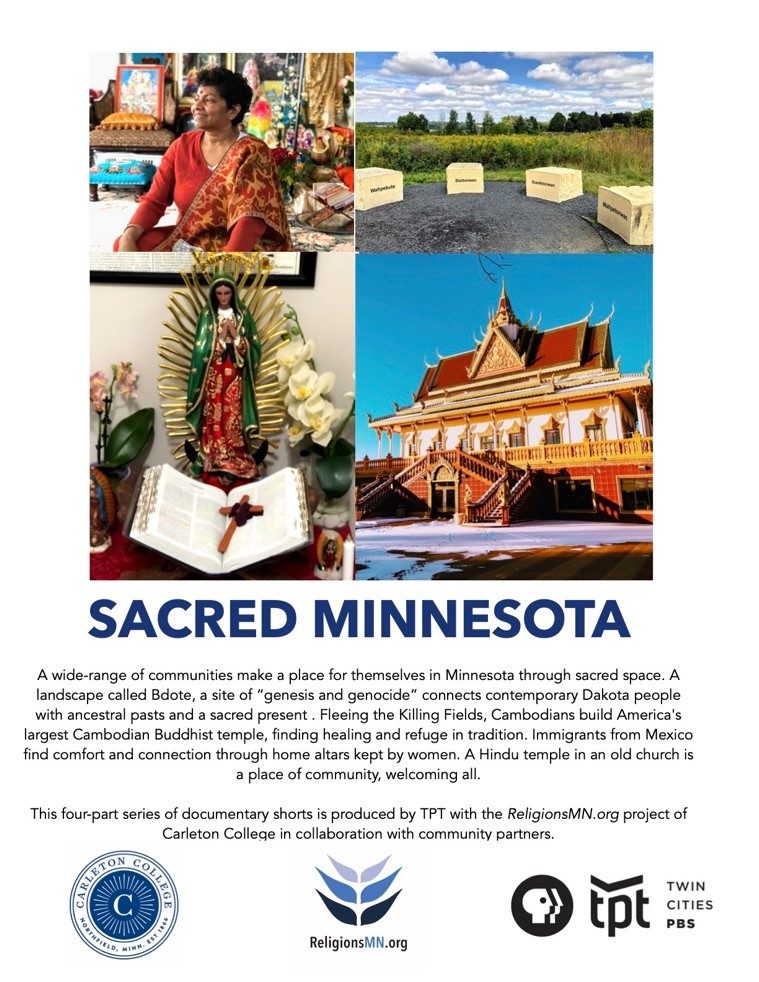Sacred Minnesota, a documentary film short project begins airing on Minnesota PBS stations: A TPT Partnership with Carleton College, the Public Works Initiative, and ReligionsMN.org
Sacred Minnesota, a series of four documentary shorts, begins airing on Minnesota’s public television stations on April through June and may be viewed anytime on TPT.org. Conceived of and developed through community partnerships established over the past 12 years by Professors Michael McNally and Shana Sippy—the series was produced in collaboration with Twin Cities Public Television, ReligionsMN.org, supported from a generous Public Television Amplify Grant and Carleton College’s Mellon Public Works Program.
The project draws upon extensive research compiled for ReligionsMN.org, curating the stories of dozens of diverse religious communities and offering educational context to help refine public conversation about Minnesotans. The two-minute documentary shorts will air between regular programming on all Minnesota public television stations. They will also be viewable on TPT’s website and, eventually, on ReligionsMN.org in perpetuity. Generous support from the Minnesota Humanities Center enables production of a series of longer 7-8 minute shorts, which will be used in educational settings and to facilitate public conversations and programming about religious and cultural difference. The longer film shorts will be completed this summer.
The work explores how communities have not only drawn on cultural resources to make a place for themselves in Minnesota but how they have variously drawn on religious traditions to make and keep sacred places, and, in some cases, to consecrate the Minnesota landscape itself.
These shorts do more than simply celebrate cultural forms of placemaking; they explore how placemaking often draws on the power and orientation that arguably only the sacred—as construed variously by different communities—can bring. The distinctive ways communities consecrate Minnesota places (or in the case of Native nations, re-consecrate and keep them) are as important as the work of sacralization that unites them.
The film shorts offer glimpses of four different worlds: indigenous Dakota people protect their place of genesis in the heart of the Twin Cities metro from desecration and their erasure; a Guyanese Hindu community finds ways to create the sacred, transmit tradition, and offer hospitality to all in repurposed spaces (a garage, a former church); Cambodian Buddhists, many of whom came to the US as refugees, create a sacred sanctuary amid rural cornfields, making space for spiritual, emotional, and physical healing from war; and Mexican women make and keep altars in their living rooms, sacralizing their homes inviting the presence of the Virgin of Guadalupe, other saints, and ancestors in their everyday lives, and invoking protection, comfort and community. Professor Michael McNally of Carleton College and Professor Shana Sippy of Centre College, co-direct the ReligionsMN project and emphasize important themes that unite the four films. McNally said, “Sacred places” enable communities to connect with ancestors across temporal and spatial boundaries and also hand down traditions to future generations.” “Each of these shorts provides us with insights,” Sippy said, “into how sacred space can be a way to anchor one’s life, serving as an environment in which people can reflect upon and reckon with traumas of the past and present.” McNally said, “while each site is unique, something that is particularly clear in the case of the Dakota, for whom the land itself has always been sacred, there are still many resonances in these stories.” As Sippy described it, everyday actions are made sacred, “for each of these communities, be they indigenous or immigrant, preserving and creating the sacred requires tremendous and unceasing labor. In some cases, it is the work of pouring cement, repairing leaky roofs, and cooking food; in others it involves lobbying and political organizing to navigate city ordinances and federal, state and local policies about land use and rights.” Sippy said, “these shorts give us a glimpse into the sacred as it is found in different types of places—natural environments, elaborate edifices, improvised and repurposed buildings, as well corners and nooks of homes. “We see the films as ways to foster public dialogue and promote greater understanding across difference,” Sippy and McNally reflected. “While the traditions of challenges facing each community make each story distinct, what happens in these places can be compelling for their similarities: peoples acknowledge sacred presence, make sense of their place in the world, and find refuge, hope and community.”
